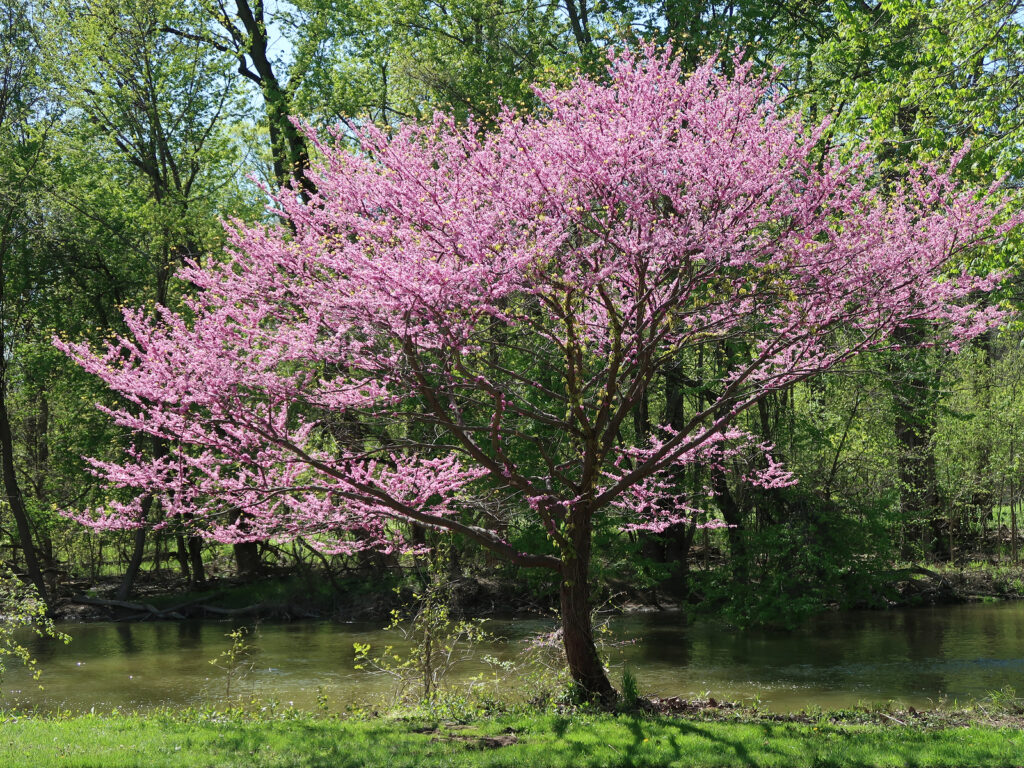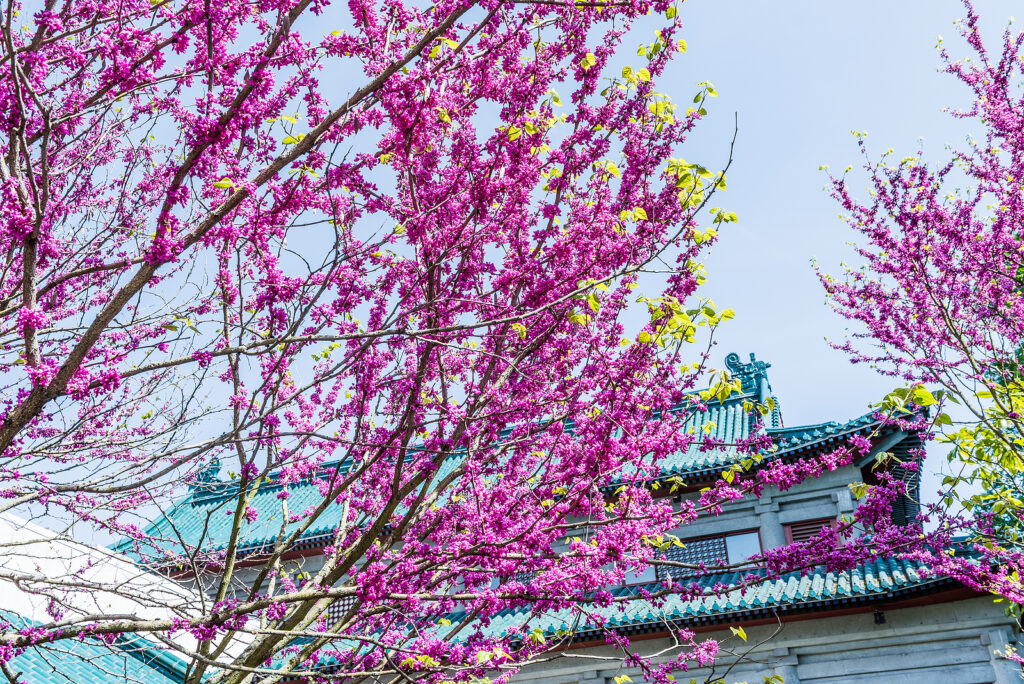Cercis–commonly called Redbud–is a mid-size deciduous tree. It produces masses of pink or rosy to purplish flowers in early spring, offers shade in summer, and is bright yellow in fall before leaves fall. Redbuds can be planted as a specimen, seasonal accent, and near the patio and small lawns.
Cercis–redbuds–is a genus of deciduous shrubs or trees native to North America, Southern Europe, and Asia. Redbuds belong to the Pea Family.
Redbuds are showy in early spring with a profusion of rose-pink to rosy-purple flowers opening before, or as, the leaves unfold. Clusters of flowers are produced on the old stems as well as on younger growth.
Redbud foliage is handsome and plants are well suited for the background of shrubberies. They do well in ordinary, well-drained soil but are best transplanted when small, older plants with established roots are sometimes rather difficult to get established.
Redbud is propagated by seeds or layers, also by greenwood cutting under glass.

Get to know Cercis – Redbud
- Plant type: Deciduous flowering tree
- Growing Zones and range: Zones 3 to 9
- Hardiness: Cold hardy
- Height and spread: 20 to 30 feet (9m) tall, 25 feet (7.6m) wide
- Form: Tree trunks divide close to the ground and then develop graceful, ascending branches; dark or charcoal gray bark
- Foliage: As flowers fade, 5-inch (12.7cm) attractive, broad, heart-shaped leaves appear, hiding the flat 5-inch (12.7cm) seed pods that follow the blossoms; late in autumn leaves turn golden yellow before falling; reddish-purple heart-shaped leaves turn lime green then mature to dark green; they turn yellow in fall
- Flowers: Before the leaves unfold, twigs, branches, and even main stems are studded with clusters of rosy-purple .8 inch (2cm) pea-shaped flowers; purplish-pink flowers appear in mid-spring; older trees form flower buds at the joints of old wood and on tree trunks; flowers are followed by flattened pealike seedpods
- Bloom time: Flowers in mid-to-late spring before leaves appear
- Uses: Specimen, patio, small lawn tree, seasonal accent
- Common name: Redbud
- Botanical name: Cercis species
- Family: Fabaceae
- Origin: Woodland margins of the Mediterranean, C. and E. Asia, North America

Where to plant Cercis – Redbud
- Grow redbud trees in full sun to partial shade.
- Grow redbud trees in any well-drained soil from sandy to clay and soil pH from acidic to alkaline.
- Plant redbud where it will be sheltered from late frosts.
When to plant Cercis – Redbud
- Set container-grown redbud trees in the garden in late winter or early spring or autumn. Redbud trees are difficult to transplant.
- Sow Cercis seed in containers in a cold frame in autumn.
- Trees transplanted in spring may not fully bloom the first year.

Planting and spacing Cercis – Redbud
- Space redbud with mature size in mind; commonly 20 to 25 feet (6-7.6m) apart.
How to water and feed Cercis – Redbud
- Give redbuds regular water to keep the plant healthy.
- Fertilize redbud by spreading aged compost around the tree to the drip line.
Cercis – Redbud care
- Prune to remove dead wood and open the canopy for light penetration.
- Protect Cercis from mechanical injury.
Cercis – Redbud pests and diseases
- Redbud trees are susceptible to canker and verticillium wilt.
- Leaf blight and downy mildew can strike foliage.
- Scale insects, weevils, caterpillars, whiteflies, and leafhoppers can cause problems.

Cercis – Redbud propagation
- Sow seed immediately upon ripening in late summer or fall. Trees take 5 to 6 years to bear flowers.
- Root semi-ripe cuttings or bud-selected clones in summer.
Cercis – Redbud varieties to grow
- Cercis canadensis, eastern redbud: native to eastern U.S. Largest (grows 25 to 35 feet/7.6-10.6m tall) and fastest-growing of the redbuds, and the aptest to take tree form. Round-headed but with horizontally tiered branches in age. Rich green, 3-6 inches (7.6-15.2cm) long leaves have pointed tips. Small, .5 inch (1.3cm) long, rosy pink flowers. Needs some winter chill to flower profusely. Valuable for filling the gap between the early-flowering fruit trees (flowering peach, flowering plum) and the crabapples and late-flowering cherries. Effective as specimen or understory tree. Varieties include ‘Alba’ (white flowers); ‘Flame’ (double pink flowers); ‘Forest Pansy’ (purple flowers); and ‘Silver Cloud’ which has splashes of silvery white in early summer; ‘Whither’s Pink Charm’ has clear pink flowers.
- C. chinensis, Chinese redbud, Chinese Judas tree, native to China, and Japan. Seen mostly as an open shrub to 10-12 feet (3.1-3.7m). Flower clusters, 3-5 inches (7.6-12.7cm) long, are deep rose, almost rosy purple. Leaves are sometimes glossier and brighter green than those of C. canadensis, with transparent lines around the edge. ‘Avondale’ is a superior form with deep purple flowers. Full sun. Zones 6 to 9.
- C. occidentalis, Western redbud, shrub, or small tree 10-18 feet (3.1-5.5m) tall and wide, usually multitrunked. All-year interest: magenta flowers in spring, handsome blue-green leaves and newly forming magenta seedpods in summer, light yellow or red foliage in fall, and picturesque bare branches holding reddish brown seedpods in winter. Best floral display with some winter chill. Very drought tolerant; excellent for seldom-watered banks.
- C. reniformis, a southwest native equivalent of eastern redbud. Leaves leathery, blue-green, 2-3 inches (5.1-7.6cm) wide, with rounded or notched tips. ‘Alba’ has white flowers. ‘Oklahoma’ has wine-red flowers and thick, glossy, heat-resistant leaves.
- C. siliquastrum, Judas tree, native to Europe and eastern Asia. Performs best with some winter chill. Generally of shrubby habit to 25 feet (7.6m), occasionally a taller, slender tree with a single trunk. Purplish rose, .5 inch (1.3cm) long flowers; 3-5 inches (7.6-12.7cm) leaves, deeply heart-shaped at the base, rounded or notched at the tip. Fairly drought tolerant.
- C. c. mexicana (C. mexicana), includes plants from many sources in Mexico. Most widely distributed is a form with a single trunk to 15 feet (4.6m), and leathery blue-green leaves and pinkish-purple flowers.



